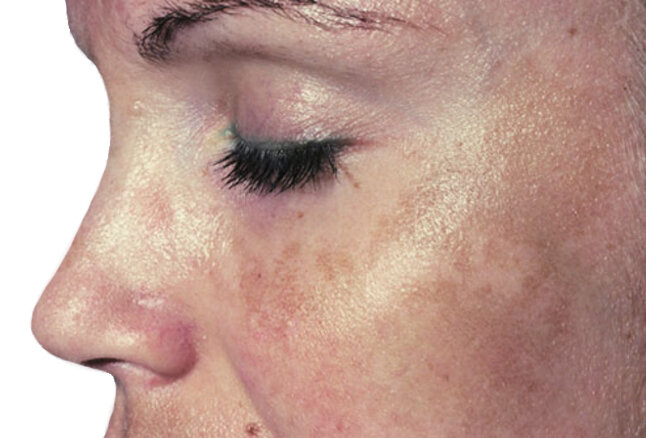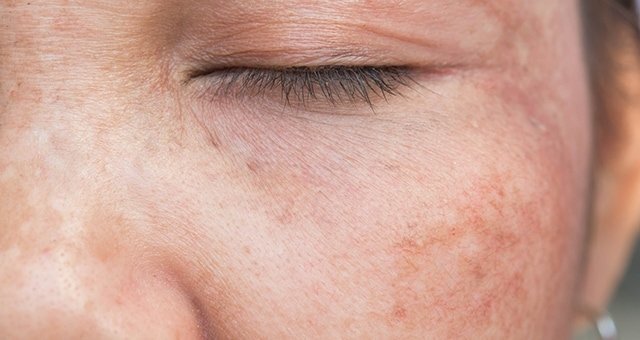Areas of Concern: Hyperpigmentation and How to Treat It
Hyperpigmentation refers to any darkening of the skin, specifically freckles, sunspots from excess sun exposure, age spots, melasma or post-inflammatory discoloration from acne, for instance. These hyperpigmentation patches can develop anywhere on the body and vary in size. They happen when the skin produces more melanin (the pigment that gives skin its color), which makes these spots appear darker than surrounding areas.
Hyperpigmentation in the form of sun spots, dark spots or age spots can be caused by too much sun exposure, hormones and aging.
Hyperpigmentation from excess sun exposure
So What Causes Hyperpigmentation?
A few common causes of discoloration include aging, inflammation and sun—and the greater your sun exposure, the greater your risk for pigmentation.
“As we age, our skin cells get disorganized and our melanocytes can overact and cause hyperpigmentation,” says Virginia McIntosh, aesthetician at Majewski Plastic Surgery and Spa. “Melanocytes are our melanin (skin pigment) forming cells.”
When the skin is exposed to sun, melanocyte density is about two times higher than if it were never exposed to sun. All of that to say: there are two main ways to prevent pigment changes in the skin. First, try to avoid exposure to the sun, and always use a broad spectrum sunscreen with 30 SPF or higher. And avoid picking your skin (that means no popping pimples). This will prevent any post-blemish pigmentation from forming after stubborn breakouts.
How Can I Treat Hyperpigmentation at Home?
If you want to lighten dark patches of pigmented skin already there, we recommend the following ingredients and medical-grade skincare products to do the job at home.
Vitamin C
Vitamin C tackles a myriad of skin concerns (texture, fine lines and dullness to name a few). But one of the main reasons it’s such a sought-after ingredient is because it can brighten and diminish discoloration. Because it’s a potent antioxidant, vitamin C encourages the skin's natural regeneration process.
Plus, just as consuming antioxidants will help your body fight free radicals, the same goes for the skin. Topically applying vitamin C neutralizes free radicals, so it’s also a great defense against future pigmentation (hint: layering it under your SPF makes sunscreen work extra hard).
SkinCeuticals CE Ferulic: For normal to dry skin, CE Ferulic will not only provide environmental protection, but it will also actively lighten lines, firm skin and brighten your complexion.
SkinCeuticals Phloretin CF Gel: For normal to oily skin, this gel diminishes the appearance of discoloration, refines skin texture and improves skin tone, while also protecting against atmospheric aging and environmental damage.
Tyrosinase Inhibitor
Common ingredients in skincare to address unwanted pigmentation, tyrosinase inhibitors (like tranexamic acid and kojic acid) will control how fast your skin produces pigment and correct the appearance of hyper pigmentation with topical use.
SkinCeuticals Discoloration Defense: For all skin types, this dark spot corrector targets visible discoloration and has been clinically proven to reduce the appearance of hard-to-treat pigmentation like stubborn brown patches and post-acne marks.
SkinMedica Lytera 2.0 Pigment Correcting Serum: Lytera addresses even the most stubborn skin discoloration while also optimizing the results of in-office treatments like chemical peels, laser therapy or microdermabrasion.
Retinol
Fading discoloration with retinol, a type of vitamin A, works by speeding up cell turnover. Because retinol can infiltrate deep into the skin, it’ll both interfere with pigment production and treat dark spots that haven’t even reached the surface yet.
SkinCeuticals Retinol 0.5%: A night cream from SkinCeuticals, this retinol will improve the appearance of pores, minimize breakouts and help any visible signs of aging, like discoloration, fine lines and wrinkles.
What In-Spa Treatments Tackle Hyperpigmentation?
Decrease in discoloration and hyperpigmentation using the Clear + Brilliant Laser.
Clear + Brilliant Laser: This laser treatment (a celeb favorite) is one of our most popular because it not only improves the appearance of fine lines (and pores), but it also tackles heavy discoloration. It works by creating microscopic treatment zones in the upper layers of the skin, thus replacing damaged skin with healthy tissue and yielding younger looking skin. McIntosh recommends a series of six treatments, followed by quarterly maintenance, to tackle hyperpigmentation. Learn more about the in-spa laser treatment here.
Photo Facial: Photofacials target unwanted pigment in the form of hyperpigmentation, brown spots, or age spots. The pigment is brought to the surface and is temporarily darker finally leaving you with more even skin tone in about 1 week. McIntosh typically one to two treatments to see best results.
Transform your skin from deep within today! Schedule your free skincare consultation with our aestheticians to talk about tackling hyperpigmentation and the right path for your skin.









